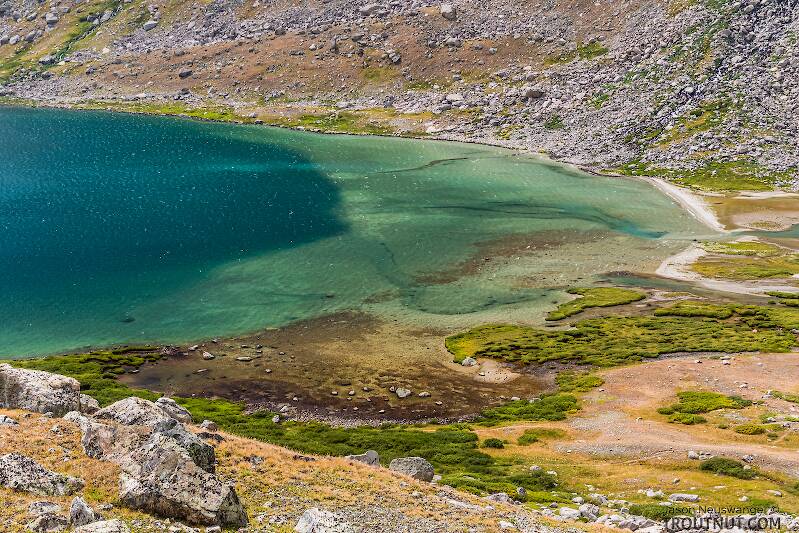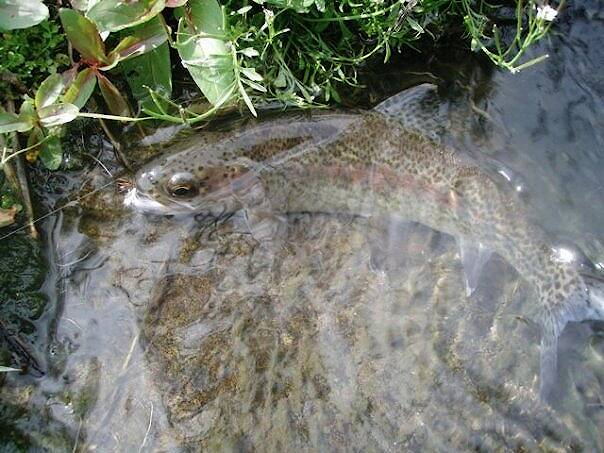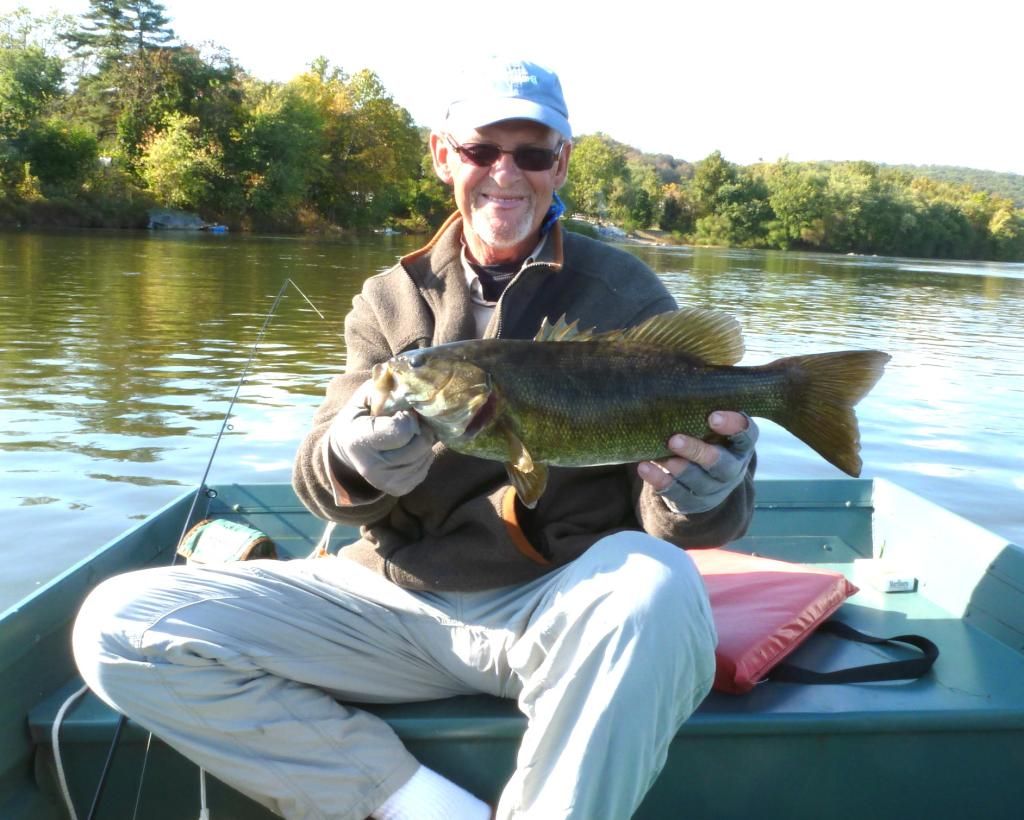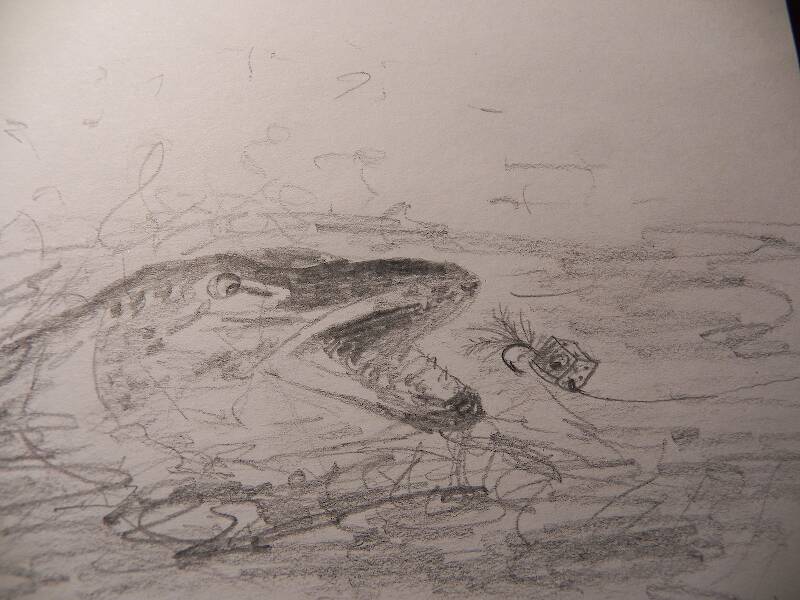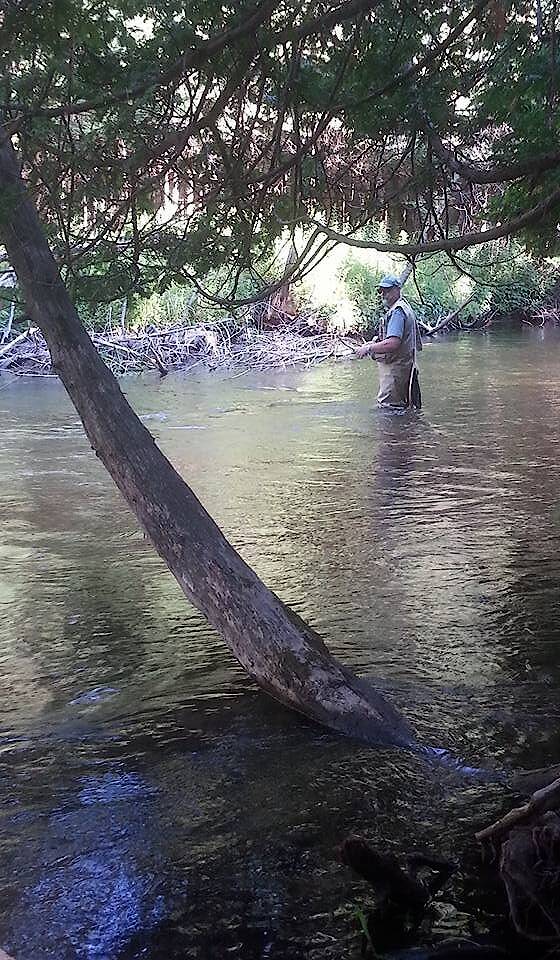
Blue-winged Olives
Baetis
Tiny Baetis mayflies are perhaps the most commonly encountered and imitated by anglers on all American trout streams due to their great abundance, widespread distribution, and trout-friendly emergence habits.
Featured on the forum

This one seems to tentatively key to Holocentropus, although I can't make out the anal spines in Couplet 7 of the Key to Genera of Polycentropodidae Larvae nor the dark bands in Couplet 4 of the Key to Genera of Polycentropodidae Larvae, making me wonder if I went wrong somewhere in keying it out. I don't see where that could have happened, though. It might also be that it's a very immature larva and doesn't possess all the identifying characteristics in the key yet. If Holocentropus is correct, then Holocentropus flavus and Holocentropus interruptus are the two likely possibilities based on range, but I was not able to find a description of their larvae.

Troutnut is a project started in 2003 by salmonid ecologist Jason "Troutnut" Neuswanger to help anglers and
fly tyers unabashedly embrace the entomological side of the sport. Learn more about Troutnut or
support the project for an enhanced experience here.
Flyman2
Posts: 5
Posts: 5
Flyman2 on Mar 6, 2015March 6th, 2015, 2:38 am EST
Hey, I'm currently tying woolly buggers, and I'm curious to know if anyone has noticed significantly better success on a particular color.
thanks
thanks
Flyflinger on Mar 6, 2015March 6th, 2015, 2:57 am EST
It depends on the water. For trout on small streams, I tie black and white, mostly 10s and 12s, and lightly weighted or unweighted. For bass I'll tie those colors and olive, brown/orange, and dark purple in 2s - 8s and somewhat weighted. I stopped using tungsten and went back to brass for beadheads or coneheads, if I do use them, because I believe the heavier tungsten made the fly zip past the bass hanging throughout the water column.
Wbranch on Mar 6, 2015March 6th, 2015, 4:02 am EST
As Henry Ford used to say about his cars "You can have any color you want as long as it is black".
Now I wouldn't go that far but I only tie three colors and one of those is designed specifically for steelhead. For trout I tie all black with 4 strands of pearl Krystal Flash on either side of the marabou tail. I also tie black marabou tail, black hackle, but an olive chenille body. For steelhead I tie all white to imitate dead minnows that have spawned and are drifting back towards the lake. The guy that invented the "Blood Dot" egg fly told me that when minnows die they turn all white but you can still see some silver in the lateral line. He said the steelhead key in on this as they are easy pickings.
Now I wouldn't go that far but I only tie three colors and one of those is designed specifically for steelhead. For trout I tie all black with 4 strands of pearl Krystal Flash on either side of the marabou tail. I also tie black marabou tail, black hackle, but an olive chenille body. For steelhead I tie all white to imitate dead minnows that have spawned and are drifting back towards the lake. The guy that invented the "Blood Dot" egg fly told me that when minnows die they turn all white but you can still see some silver in the lateral line. He said the steelhead key in on this as they are easy pickings.
Catskill fly fisher for fifty-five years.
RleeP on Mar 6, 2015March 6th, 2015, 4:20 am EST
If you're fishing streams where crayfish are an important forage item for trout, its hard to beat an olive bugger with a brown tail or vice versa.
Actually, you can tie just about any natural color combo you want and be fairly confident that the effort will have been worthwhile. Its difficult to design a wooly bugger that won't catch fish...
Actually, you can tie just about any natural color combo you want and be fairly confident that the effort will have been worthwhile. Its difficult to design a wooly bugger that won't catch fish...
Wbranch on Mar 6, 2015March 6th, 2015, 4:28 am EST
I agree an all brown or even a brown and orange bugger would be a great crayfish replica.
Catskill fly fisher for fifty-five years.
Gus on Mar 6, 2015March 6th, 2015, 11:51 am EST
whenever I travel I like to take a couple black woolies with flash in the tail. I've caught trout from VT to OR and bass and pan fish all the way down in FL.
"How do you help that son of a bitch?"
"By taking him fishing"
-A River Runs Through It
www.jsrods.com
"By taking him fishing"
-A River Runs Through It
www.jsrods.com
Flyflinger on Mar 7, 2015March 7th, 2015, 5:01 am EST
I agree an all brown or even a brown and orange bugger would be a great crayfish replica.
Yup. That's why I tie brown and orange. It works wherever crayfish seem abundant. When I fished the Susquehanna River years ago, the banks were just littered with dead crayfish. Then, it wasn't remarkable at all to have a century day of smallmouth bass with that pattern. Want a bigger fish? Just tie on a larger Woolly Bugger. God bless Ron Blessing, another talented PA angler, for inventing that fly.
Wbranch on Mar 7, 2015March 7th, 2015, 7:43 am EST
Catskill fly fisher for fifty-five years.
RMlytle on Mar 7, 2015March 7th, 2015, 8:17 am EST
My favorites are all black, all white, olive tail and body with grizzly hackle, and any combo of orange and brown. All orange and all yellow work okay for bass but the other colors are far more productive.
Roguerat on Mar 7, 2015March 7th, 2015, 9:12 am EST
One of my favorites is Pearl chenille with black hackle palmered over it, pearl flashabou for the tail- tied on a sz 8 or 10 3x long streamer hook it makes a fairly convincing minnow imitation.
Roguerat
Roguerat
Oldredbarn on Mar 7, 2015March 7th, 2015, 10:30 am EST
created by Russell Blessing, Pennsylvania Fly Tyer as early as 1967 to resemble a hellgrammite
I think his original colors were black chenille and olive tail. Or was it the other way around?
Spence
"Even when my best efforts fail it's a satisfying challenge, and that, after all, is the essence of fly fishing." -Chauncy Lively
"Envy not the man who lives beside the river, but the man the river flows through." Joseph T Heywood
"Envy not the man who lives beside the river, but the man the river flows through." Joseph T Heywood
PaulRoberts on Mar 7, 2015March 7th, 2015, 2:44 pm EST
All colors can work. One can attempt to "match the hatch" or offer a potential generalized prey item. It may need to stand out or be obscured depending on conditions and circumstances. Whim of the angler and fish often weighs in too.
Jmd123 on Mar 7, 2015March 7th, 2015, 2:49 pm EST
Here's one to try. I call it the POG Bugger - Peacock, Olive, and Grizzly. Use peacock herl (several strands wound together) for the body, natural grizzly hackle palmered-style (tied in at front, wrapped from head to tail and then counter-wrapped with fine green wire), and olive-dyed grizzly marabou for the tail. I sometimes like to add black bead-chain eyes for weight instead of underbody weighting. The same thing tied with brown in place of the olive and peacock works very well too, especially if you can find good brown-dyed grizzly marabou (Feather-Craft carries a variety of grizzly marabou colors).
Both of these have worked very well on trout as well as panfish and bass of course.
Jonathon
Both of these have worked very well on trout as well as panfish and bass of course.
Jonathon
No matter how big the one you just caught is, there's always a bigger one out there somewhere...
TNEAL on Mar 9, 2015March 9th, 2015, 6:01 am EDT
dark olive dyed grizzly marabou tail; peacock or dark olive chenille body; grizzly dyed dark olive "palmered". Great on trout and panfish. I noticed Jonathon actually described palmering as originally done.
Jmd123 on Mar 9, 2015March 9th, 2015, 1:27 pm EDT
Tim, you were the one who pointed out to me that I was using the original method when I didn't even know it. I find that the wire binding not only helps keep the hackle from becoming loose (especially when dealing with toothy critters like trout), it also adds a little bit more flash to the fly. I do this on my Elkhair Caddis as well with the finest wire I can use.
Jonathon
Jonathon
No matter how big the one you just caught is, there's always a bigger one out there somewhere...
PaulRoberts on Mar 9, 2015March 9th, 2015, 5:00 pm EDT
"Bugger" caught small-stream brown; a true leviathan:

Bugger color was a muddy-gray with a black bulbous head -hellgrammite colors and a true match-the-hatch circumstance.
Stomach pump results from another big brown from the same stretch, showing the range of "images" that signal "food": cranefly larvae, hellgrammites, and scuds:

Sketches in my fishing journal of collected cranefly larvae in that stretch:


Bugger color was a muddy-gray with a black bulbous head -hellgrammite colors and a true match-the-hatch circumstance.
Stomach pump results from another big brown from the same stretch, showing the range of "images" that signal "food": cranefly larvae, hellgrammites, and scuds:

Sketches in my fishing journal of collected cranefly larvae in that stretch:

Jmd123 on Mar 9, 2015March 9th, 2015, 5:11 pm EDT
Paul, those stomach contents look ripe for Woolly Bugger imitation - just vary the sizes and colors! No wonder Mr. Brown inhaled your fly, looks like you pretty much nailed it. Well done!
In the springtime at my favorite brookie pond, the mottled brown variant I described above works extremely well on the brookies and the perch in the same pond. I've often wondered if it imitates dragonfly nymphs? Doesn't do much later in the year but in May and early June that fly is deadly out there. I have also seen plenty of leeches in that pond, but they tend to be the large, swimming red and black variety. Maybe a Bugger with a black top and red bottom? Oh, and I haven't gone snorkeling there since I noticed all of those big (up to 5") leeches...
Jonathon
In the springtime at my favorite brookie pond, the mottled brown variant I described above works extremely well on the brookies and the perch in the same pond. I've often wondered if it imitates dragonfly nymphs? Doesn't do much later in the year but in May and early June that fly is deadly out there. I have also seen plenty of leeches in that pond, but they tend to be the large, swimming red and black variety. Maybe a Bugger with a black top and red bottom? Oh, and I haven't gone snorkeling there since I noticed all of those big (up to 5") leeches...
Jonathon
No matter how big the one you just caught is, there's always a bigger one out there somewhere...
Wbranch on Mar 9, 2015March 9th, 2015, 6:12 pm EDT
Looks to be at least 26" based on cork and reelseat is usually about 10". Monster. Recent catch?
Catskill fly fisher for fifty-five years.
PaulRoberts on Mar 9, 2015March 9th, 2015, 8:43 pm EDT
Paul, those stomach contents look ripe for Woolly Bugger imitation - just vary the sizes and colors! No wonder Mr. Brown inhaled your fly, looks like you pretty much nailed it. Well done!
Thanks, Jonathan!
Matt, it was 23" -my largest small-stream brown to date -caught sometime in the mid 90's. (My biggest lake-run browns were 29-1/2" -two of them.) You can see the dots on the rod I use to measure fish with. They're dots of phosphorescent vinyl fabric paint, each with a spot of nail polish to hold them. Work well in low light and can be 'charged' at night.
That brown had a hook split shot and length of 4lb line coming from its gullet. It must have scared someone prior to my catching it lol.
TNEAL on Mar 10, 2015March 10th, 2015, 3:28 am EDT
Jonathan, your mottled brown is what I'm seeing as mottled dark olive. Right on with the thought about dragon fly nymphs as my own observations show pretty much exactly the same. I've always thought that was the reason for the success of that color combo.
Quick Reply
Related Discussions
Topic
Replies
Last Reply
2
Oct 18, 2010
by Jmd123
by Jmd123
Five days of warmwater flyfishing in southeastern Michigan - from Jonathon
In Fishing Reports by Jmd123
In Fishing Reports by Jmd123
0
Jul 22, 2009
by Jmd123
by Jmd123
4
Oct 24, 2009
by Keeper33
by Keeper33

